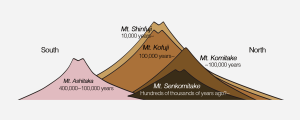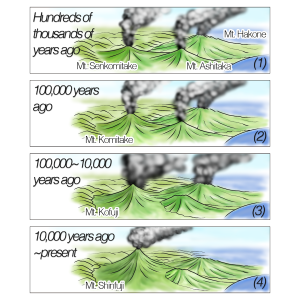Under construction|2.1.1 Mt. Fuji grew rapidly in its early days
*The contents may be subject to change without prior notice.
K. Z. Nanjo1) and M. Yoshimoto2)
1) NaDiR, Global Center for Asian and Regional Research, University of Shizuoka
2) Mount Fuji Research Institute, Yamanashi Prefectural Government
Present-day Mt. Fuji is a volcano built up to four different volcanoes (Fig. 2-1). First, a volcano called Mt. Senkomitake was formed, followed by the volcanoes Mt. Komitake, then Mt. Kofuji, and finally Mt. Shinfuji, Japan’s highest mountain, which we know today as Mt. Fuji (Fig. 2-2).

Fig. 2-1: The four distinct phases of volcanic activity in the formation of Mt. Fuji. Mt. Ashitaka is located to the south.

Fig. 2-2: How Mt. Fuji was formed.
(1) Mt. Senkomitake was formed slightly to the north of the current location of Mt. Fuji hundreds of thousands of years ago.
(2) Then, Mt. Komitake grew in almost the same place until about 100,000 years ago. Part of this mountain can still be seen near the Fujisan Komitake Shrine at the fifth station of Mt. Fuji on the Fujiyoshida Route.
(3) Mt. Kofuji began being formed in the middle slope of Mt. Komitake about 100,000 years ago.
(4) Mt. Shinfuji began growing over Mt. Kofuji about 10,000 years ago.
If the weather is fine, from the window of a bullet train traveling on the Tokaido Shinkansen Line you can see two volcanoes: one is Mt. Fuji and the other is Mt. Ashitaka standing before Mt. Fuji. These volcanoes have been active for hundreds of thousands of years. Incidentally, it is known that Mt. Ashitaka was once higher than Mt. Fuji. Mt. Hakone, another volcano near Mt. Fuji, has been active for hundreds of thousands of years. Vigorous volcanic activity continues around Mt. Fuji.
Mt. Fuji had already formed its current shape in the time of Mt. Kofuji, from about 100,000 years ago (Fig. 2-1). The lifespan of Japanese stratovolcanoes is estimated to be hundreds of thousands of years to a million years, so we can say that Mt. Fuji is a young volcano, since it began volcanic activity about 100,000 years ago. The large eruption volume and discharged rate (eruption volume per unit time) contributed to the formation of this iconic Japan’s-highest mountain. While it has not been fully elucidated why the eruption volume and discharged rate of Mt. Fuji are several times larger than those of other Japanese stratovolcanoes, the geological position of Mt. Fuji is considered to be part of the reason. In the vicinity of Mt. Fuji, there are the Eurasian plate on which the western part of Japan sits, and the North American plate on which the eastern part sits. Beneath these plates, the Philippine Sea plate is subducted from the south, and beneath the Philippine Sea plate lies the Pacific plate from the east. Probably, the unique interactions among these four tectonic plates made the underground structure of Mt. Fuji complicated, and as a result, a huge volume of magma was produced and erupted, accelerating the rapid growth of the mountain.